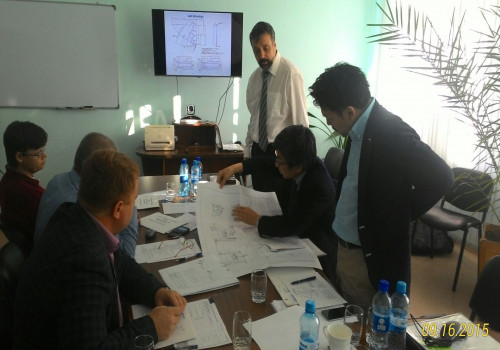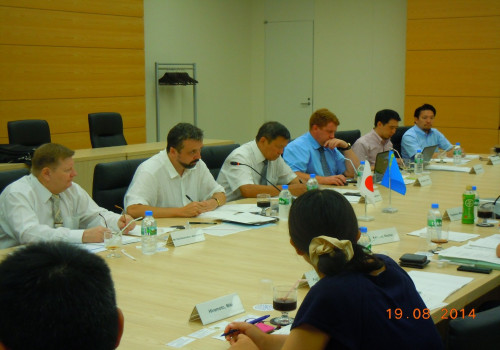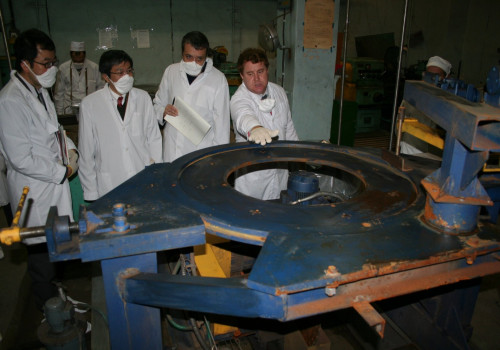RESEARCH EFFORTS TO SUPPORT ELIMINATION OF “FUKUSHIMA” NPP ACCIDENT (FUKUSHIMA PROJECT)
25 May 2022



30 Projects to the 30th Anniversary of NNC RK!
Project No.22. The period of 2015–2016. RESEARCH EFFORTS TO SUPPORT ELIMINATION OF “FUKUSHIMA” NPP ACCIDENT (FUKUSHIMA PROJECT)
On March 11, 2011, the Great East Japan Earthquake and the resulting tsunami occurred off the coast of Japan, the largest earthquake in the history of the country. The main event of those days was the accident at the Fukushima-Daichi NPP, the largest accident at the nuclear power plant after Chernobyl disaster. Tsunami blacked out the station that caused overheating of reactors and subsequent explosions of three power units during the period of March 12-15. In December 2013, NPP was officially shut down. The operations on elimination of accident consequences are still ongoing at the territory of the station.
During the Fukushima Daiichi accident, the nuclear fuel was melted due to stoppage of the functioning of whole cooling system of the reactor. The resulting corium moved around and could solidify in various areas of the reactor facility (both inside and outside of the reactor power vessel). One of the tasks to be solved to eliminate the consequences of this accident is the removal of solidified corium from the reactor vessel and NPP containment. The main problem in solving of this task is the unavailability of reliable data on the condition and properties of solidified corium (debris) (consisting from fuel melting and other structural elements of the reactor core) that makes it difficult to develop and create tools for elimination.
The great assistance in NPP accident consequences elimination for Japanese specialists were the results of studies conducted in cooperation with Kazakhstani specialists at the unique research base of the National Nuclear Center of RK. Joint project has homonymic name as – Fukushima Debris. FD (Fukushima Debris) project is focused on modelling and subsequent study of solidified fragments of the core melting of Fukushima-1 NPP reactor in order to substantiate creation of structures of mechanisms on reprocessing of real solidified fragments of the core melting of the Fukushima-1 NPP emergency reactors. The operations on the project started in September 2014, and conducted at the unique research base of the National Nuclear Center of RK by the order of Toshiba company under the facilitation of Marubeni US Ltd. Experimental studies allowed to study properties of solidified fragments of model melting of the core of Fukushima-1 NPP reactor and to obtain data required for creation of mechanisms structures on reprocessing of real solidified fragments of the core melting of the emergency reactors at the Fukushima-1 NPP.
The project works were completed in March 2016. During the implementation of project three large-scaled experiments were carried out at the “Lava-B” facility and 12 small-scale experiments at the bench “VChG-135”, the range of material testing studies was carried out to determine properties of solidified corium, the possibilities of corium cutting by abrasive tool was studied and the speed of the cutting process is estimated. After successful conducted large-scale and small-scale experiments, the project was completed in March 2016.
Taking into account the importance of obtained data, Japanese side considers the possibility of further cooperation under this project. All these issues were discussed during the working visit of Bakytzhan Dzhaksaliyev, Vice-Minister of Energy RK, and Erlan Batyrbekov, Director General of RSE NNC RK in November 2016 to the NPP Fukushima-1 in Japan.
The outcome of fruitful cooperation between Japan and Kazakhstan for peaceful use of nuclear energy was: upgrading of experimental base for research studies towards safety of nuclear energy, development of new experimental facilities and devices, training of qualified scientific and technical staff. The current unique experience created the potential in Kazakhstan that can be effectively used in safe development of nuclear energy.
Latest news by category:
-
Participation in IAEA International Fusion Research Council Meeting on Controlled Thermonuclear Fusion
25 December 2025
-
NNC RK Participated in CIS Commission Meeting on Peaceful Use of Atomic Energy
17 December 2025
-
Pivotal Role of Kazakhstan in Global Thermonuclear Fusion Research
17 December 2025
-
Enhancing Human Resources Development with Support of JAEA
09 December 2025